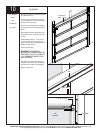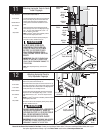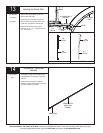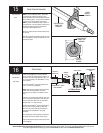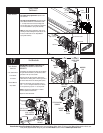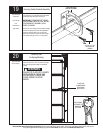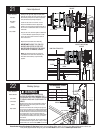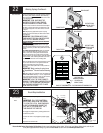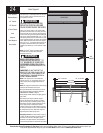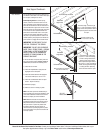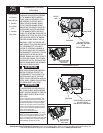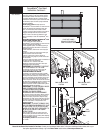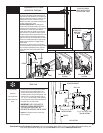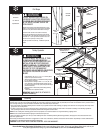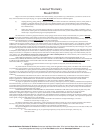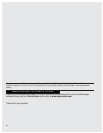
Tools Needed:
22
Please Do Not Return This Product To The Store. Contact your local Wayne-Dalton dealer. To find your local Wayne-Dalton dealer, refer to your
local yellow pages/business listings or go to the Find a Dealer section online at www.wayne-dalton.com
onto the winding shaft, pull down to add 3/10 of a
turn. Watch as three teeth of the ratchet wheel pass
over the pawl, creating three “clicks”.
Remove Spring Tension: To remove spring
tension, ensure the ratchet and socket is set so
that it will tighten counter clockwise on the right
hand side and clockwise on the left hand side. It is
recommended that a regular 5/8” wrench be used.
Place the wrench onto the winding shaft. Pull down
on the wrench to relieve pressure between the
pawl and the ratchet wheel. Push in on the pawl
to allow the three ratchet wheel teeth to pass by
the pawl, as you carefully allow the wrench to be
rotated upward by the spring tension. Release the
pawl to allow it to engage with the ratchet wheel.
IMPORTANT: BE PREPARED TO HOLD
THE FULL TENSION OF THE SPRING.
IMPORTANT: DO NOT ADD OR REMOVE
MORE THAN 1 SPRING TURNS (1 SPRING
TURN EQUALS 10 TEETH ON RATCHET
WHEEL) FROM THE RECOMMENDED
NUMBER OF TURNS SHOWN ON THE
SPRING TURN CHART.
If the door still does not operate easily, lower the
door into the closed position, UNWIND SPRING (S)
COMPLETELY, and recheck the following items:
1.) Check the door for level.
2.) Check the TorqueMaster
®
spring tube and
flagangles for level and plumb.
3.) Check the distance between the flagangles-
must be door width plus 3-3/8” to 3-1/2”.
4.) Check the counterbalance cables for equal
tension - adjust if necessary.
5.) Rewind the spring(s).
6.) Make sure door isn’t rubbing on jambs.
NOTE: If an idrive opener was installed and you
have completed your rear support installation, refer
to the idrive Installation Instructions and Owner’s
Manual to complete your idrive installation.
NOTE: Windows will cause the top section to be
significantly heavier than the remaining sections.
Wayne-Dalton attempts to balance the door at
the top & bottom. To prevent any sudden door
acceleration between the top & bottom, we
recommend motor operating all glazed top doors.
Doors with windows in top sections should not be
manually operated.
Rear Support Continued...
PERFORATED ANGLE
(3) 5/16”
BOLTS & NUTS
Horizontal track
Perforated
angle brace
Sound framing members
24”MAX
Horizontal track
Perforated
angle brace
Perforated angle - bolted using (2)
5/16” x 1-5/8” hex head lag screws to
ceiling member and parallel to width of
door. Space lag screws no further than
24” apart.
Sound framing members
Bolt must extend into the
track to serve as a roller stop
24”MAX
Bolt must extend into the track
to serve as a roller stop
Perforated angle -bolted using
(2) 5/16” x 1-5/8” hex head lag
screws to ceiling members and
parallel to width of door. Attach
vertical perforated angle between
the (2) 5/16” x 1-5/8” hex head lag
screws, securing perforated angle
to ceiling members. Space lag
screws no further than 24” apart.



